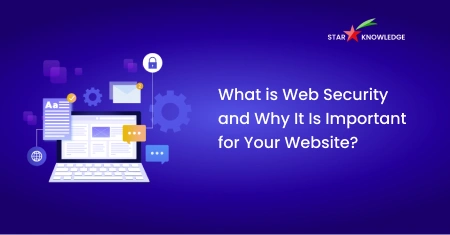
04 Feb What is Web Security and Why It Is Important for Your Website?
4 FEB 2021

Today we are completely dependent on businesses or services that are totally digital or are supported by digital channels. Common things business leaders really think of, is a website really needed and how secure is our website to transact? With an increased amount of business across the digital landscape, we can see an upward trend of cyber attacks making the business websites vulnerable and leaving them at the mercy of the infiltrators, hence securing websites is important.
What is Web Security?
Protecting a website against malfunctions, phishing, cyber crimes, or cyber-attacks to avoid data loss of the company or customers is called Web Security. Scanning an internet site for vulnerabilities or security testing is ever needed to defend against the thefts or loss that occurs due to digital hackers.
Introduction to web/cyber security: Cyber Security in the current landscape becomes the primary shield and with the advancement in technology, you will need continuous detection, monitoring, upgrades, and patches to avoid risks. By implementing a series of protective measures and protocols the website can be protected from being attacked or hacked.
To keep up with the new threats that come with advanced technology, security features for the website must be implemented from the start and proactively monitored and maintained. When a website is hacked or attacked, it usually crashes or slows down, loses traffic, and loses sensitive client information.
What are the types of Web Security Risks?
Some of the most common types of risks that arise due to lack of proper website protection are
- Malware: Some software that is specifically designed to disrupt, damage, or gain unauthorized access to a computer system.
- Backlisting: If search engines find any malware in the website it will be highlighted with a warning sign that makes visitors exit from your web page and your site can be removed from the search engine page results.
- Vulnerability exploits: Cyber hackers can get a chance to access your site and your business information stored on it by exploiting weak areas in a site, using an obsolete plugin.
- Defacement: It is a type of attack on a website that changes the visual appearance of the site or a webpage.
- Sensitive data exposure: Hackers use software to pass sensitive information via URLs, poorly constructed code, sessions that raise the website vulnerability risk.
- Buffer Overflow: It Occurs when adjacent memory locations of the software are overwritten, with data and this overwriting can be exploited to inject malicious code into the memory, creating the vulnerability in the targeted software.
The need for web safety should be taken with a proactive approach, to defend the web applications from malicious software that is injected into the site to gather data, redirect traffic, or even hijack computer resources.
Remember, the vulnerabilities will not only destroy your web application but also results in loss of reputation, a decrease in the number of visitors.
By implementing the following precautions/best practices the security of the website is proactively managed that safeguards your website and visitors resulting in increased revenue and growth.
- SSL certificates: SSL certificates protect the data collected by your website, like emails, passwords, user details, credit card details, etc., as it is transferred from your site to a server.
- Web application firewall (WAF): It stops automated attacks that commonly target small or lesser-known websites.
- Website security scanner: A website scanner looks for vulnerabilities, malware, and other security problems so that you can mitigate them correctly.
- SQL Injection: SQL injection provides unauthorized access into organization data and insights, resulting in data breaches. Through SQL injection hackers will be having access to the database and authority to alter, add, or edit data in the database. Hence it is better to prevent SQL injection to avoid website security breaches.
- Software updates: Websites hosted on a content management system (CMS) are at a higher risk of compromise due to weaknesses and security issues often found in third-party plugins and applications. These can be secured by installing updates to plugins and core software in a timely manner.
- Secure your site with HTTPS: Hypertext Transfer Protocol Secure (HTTPS) is an internet communication protocol that safeguards the integrity and confidentiality of data between the user’s computer and the website. Data sent using HTTPS is protected via Transport Layer Security protocol, which affords three key layers of protection:
- Encryption: Encrypting the exchanged data to keep it protected from eavesdroppers.
- Data integrity: Data can’t be changed or corrupted during transfer, purposely or otherwise, without being detected.
- Authentication: It protects against attacks and creates user trust, which translates into other business benefits.
- SSO based Multi-Factor Authentication for Secure Website:
- Single Sign-On (SSO) is an advanced authentication technique that streamlines the login process, permitting you access to multiple applications by logging in just once.
- Multi-Factor Authentication (MFA) allows you to add a layered authentication process by merging login credentials with independent identity elements.
- Diligence, Policies, and Firewalls for Cross-site script (XSS) attack: Diligence, Policies, and Firewalls are the most commonly used solutions for protecting against XSS and other website attacks. Cross-site scripting is used by attackers to insert malicious code into vulnerable web apps.
- XSS Attack: If Any user is allowed to add the content directly on your web page it will result in an XSS attack as the hacker will inject malicious JavaScript into your web page directly leading to increased security risks.
- Implement secure backup and recovery: Businesses small or large should understand the impact of data loss due to a catastrophic occurrence. Having a strategy in place to get back up and running should something happen is vital to survival.
- Web App Firewalls: This helps you get a hold over the internet traffic and their behavior by serving as a secure web gateway and protecting attacks, cross-site scripting, file inclusion, SQL injection, etc.,
Following these best practices protect your visitors from the following cyber threats,
- Data Theft: Hackers frequently try to steal sensitive information such as payment information, email, and other details.
- Phishing: Phishing attacks will not happen only to email, but also it happens for websites where hackers trick the visitors to provide sensitive information by designing a similar layout.
- Malicious redirects: These types of attacks redirect visitors to a malicious website from a website visitors intended to visit.
- Session hijacking: These types of cyber/website attacks force visitors to take undesired actions on the site by taking over users’ sessions.
- SEO Spam: Spam links, attractive comments can be put on web pages to confuse the visitors to drive traffic to malicious websites.
Finally, I feel you have a better understanding of what a secure website is. and the methods mentioned above are the most basic, yet most effective, ways to keep your website safe from threats. However, you must always be vigilant in protecting your website and never stop looking for ways to improve its security.
Get in touch with us to find out how we can help keep your website safe and secure.
Our Related Posts
B2B E-Commerce Trends
Hoping to extend your business employing an e-commerce solution? Here are a few actualities that may help B2B e-commerce to get….
6 Reasons to Choose AngularJS for your Next Project
Are you plotting to develop a grandiose web-application or need a simple prototype? AngularJS is the right decision. AngularJS is a widely….
Top Best Web Design Trends for 2018
To architect the experiences of tomorrow, you must first design the interactions of today….





No Comments